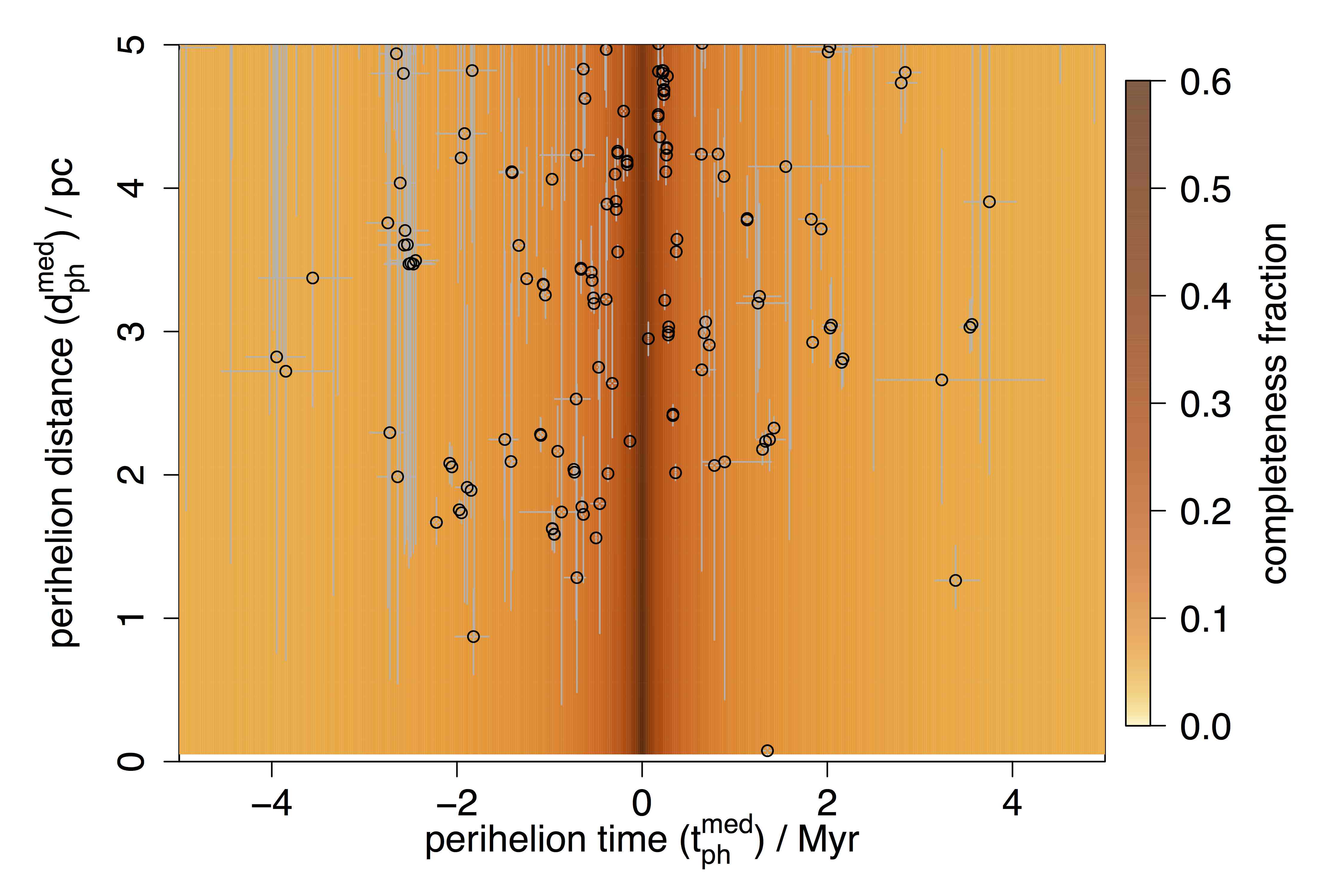IoW_20170831 - Gaia
Image of the Week |
Close stellar encounters from the first Gaia data release |
 |
|
Figure 1: The open circles show the time (horizontal axis) and distance (vertical axis) of the closest approach of stars to the Sun. Negative times indicate times in the past from today. Each point has been calculated as the median of the distribution of a swarm of surrogate particles which have been integrated through a Galactic potential. The "error" bars show the limits of the 5% and 95% percentiles of these distributions (which together form an asymmetric 90% confidence interval). That is, the swarm is used to propagate the uncertainties in the TGAS measurements to uncertainties in the perihelion parameters. The background colour (scale on the right) indicates the estimated completeness of the TGAS survey. That is, if all TGAS stars had radial velocities (and most do not), this gives the probability that a star with any particular perihelion parameters would be present in TGAS. Image credit: Coryn Bailer-Jones |
| Stars which pass close to the Sun could have a noticeable impact on the solar system. For example, if close, slow, and massive enough, they could perturb the paths of Oort cloud objects, sending them into the inner solar system where they become visible as long-period comets. The precise astrometry from Gaia makes it possible to perform a large-scale systematic search for such stars, and on a much larger scale than was done with Hipparcos. A new study has done just this with data from the first Gaia data release, by combining the five-dimensional phase space information in the TGAS catalogue - positions, parallaxes, proper motions - with radial velocities from other surveys. The motions relative to the Sun of over 300 000 TGAS stars were traced through the Galaxy and their closest approach to the Sun - in the past or future - determined. 97 stars (corresponding to the open circles in the figure above) were found which will pass within 5pc of the Sun (5pc translates to about 154 trillion kilometres or 154 x 1012 kilometres). Among these is the well-studied future encounter Gliese 710, now found by Gaia to come much closer than previously known, at a distance of just 0.05pc to 0.076pc or about 1.5 to 2.25 trillion kilometres. But beyond just finding encounters among what TGAS could observe, this study corrected for what TGAS could not observe in order to infer the overall rate of close stellar encounters. This was done by adopting a simple model of the positions and motions of stars, and then seeing how the distribution of their perihelion parameters is changed by the TGAS selection function. This incompleteness is shown as the background colour scale in the figure (and is primarily due to the fact that TGAS does not include stars outside the approximate range G=4.5 to G=13.5). By combining this incompleteness map with the observed distribution of encounters (and considering also that only 16% of TGAS stars have radial velocity measurements), the overall current rate of encounters could be inferred. This was found to be 545 ± 59 stars per million year coming with 5pc. The number is expected to scale quadratically with distance, so would correspond to (for example) 21.8 ± 2.4 stars per million year with 1pc. This includes all types of stars, and is somewhat higher than previous estimates. This study will receive a huge boost with the second Gaia data release. That release will not only contain full astrometry on many more (and more distant) stars; it will also include radial velocities on several million stars. The selection function should also be better defined, meaning that a more reliable estimate of the encounter rate can be derived. Two press releases came along with this story, one by MPIA and one on the ESA portal. For more in-depth information, please have a look at the article "The completeness-corrected rate of stellar encounters with the Sun from the first Gaia data release" or get in contact with C.A.L. Bailer-Jones. |
|
Credits: ESA/Gaia/DPAC, Coryn Bailer-Jones, Max Planck Institute for Astronomy, Heidelberg, Germany [Published: 31/08/2017] |
- Removed a total of (4) style text-align:center;
- Removed a total of (6) style text-align:justify;
- Removed a total of (1) border attribute.
- Removed a total of (1) cellpadding attribute.
- Removed a total of (1) cellspacing attribute.
Image of the Week Archive
- Removed a total of (1) border attribute.
- Removed a total of (1) cellpadding attribute.
- Removed a total of (1) cellspacing attribute.








































 Sign in
Sign in
 Science & Technology
Science & Technology